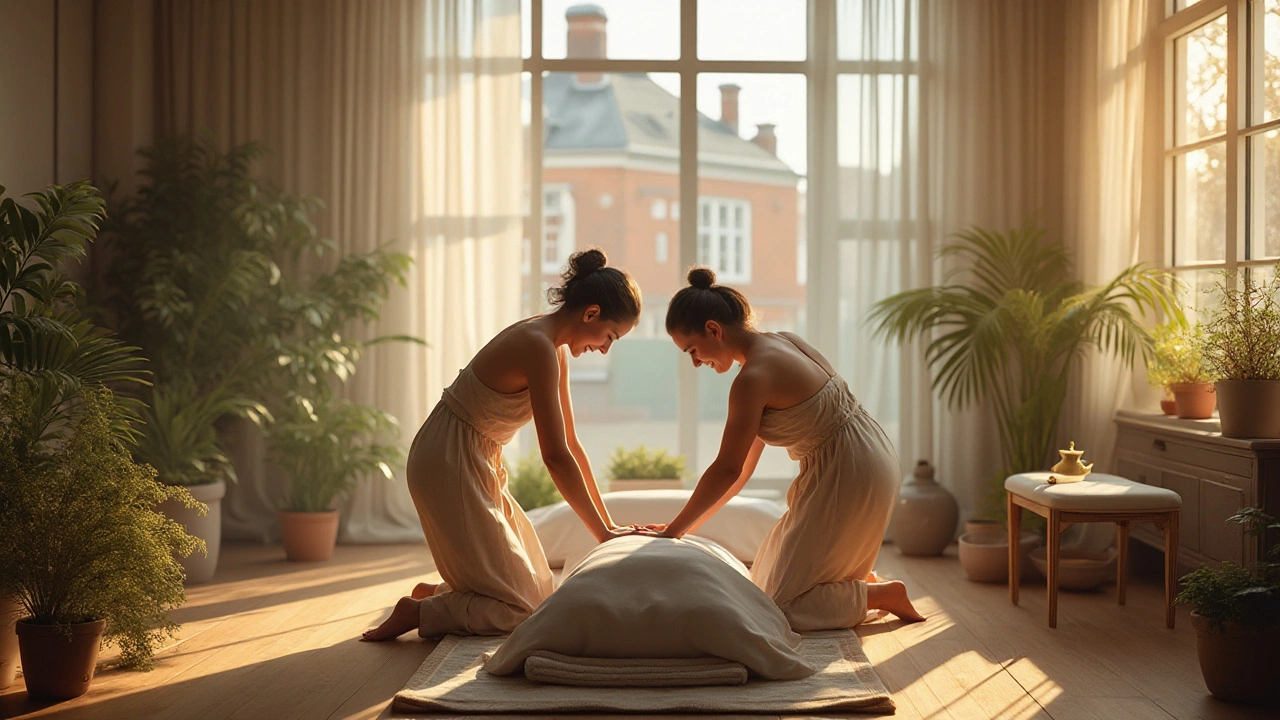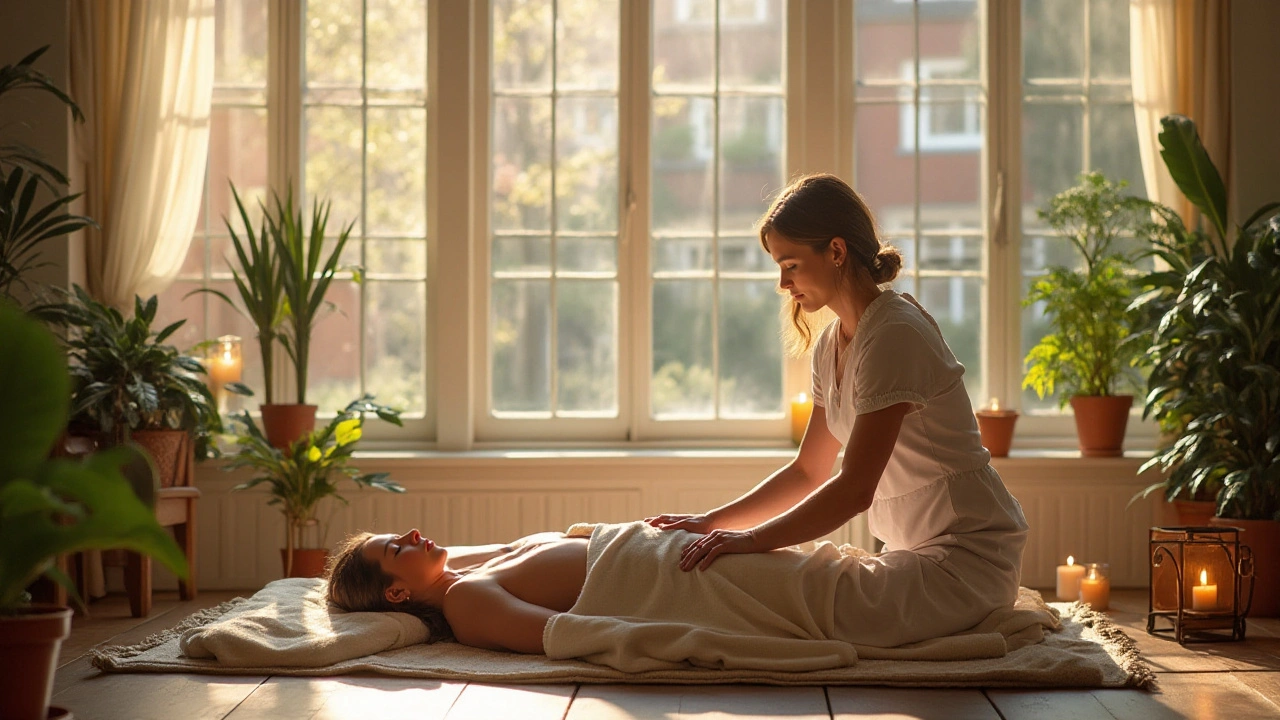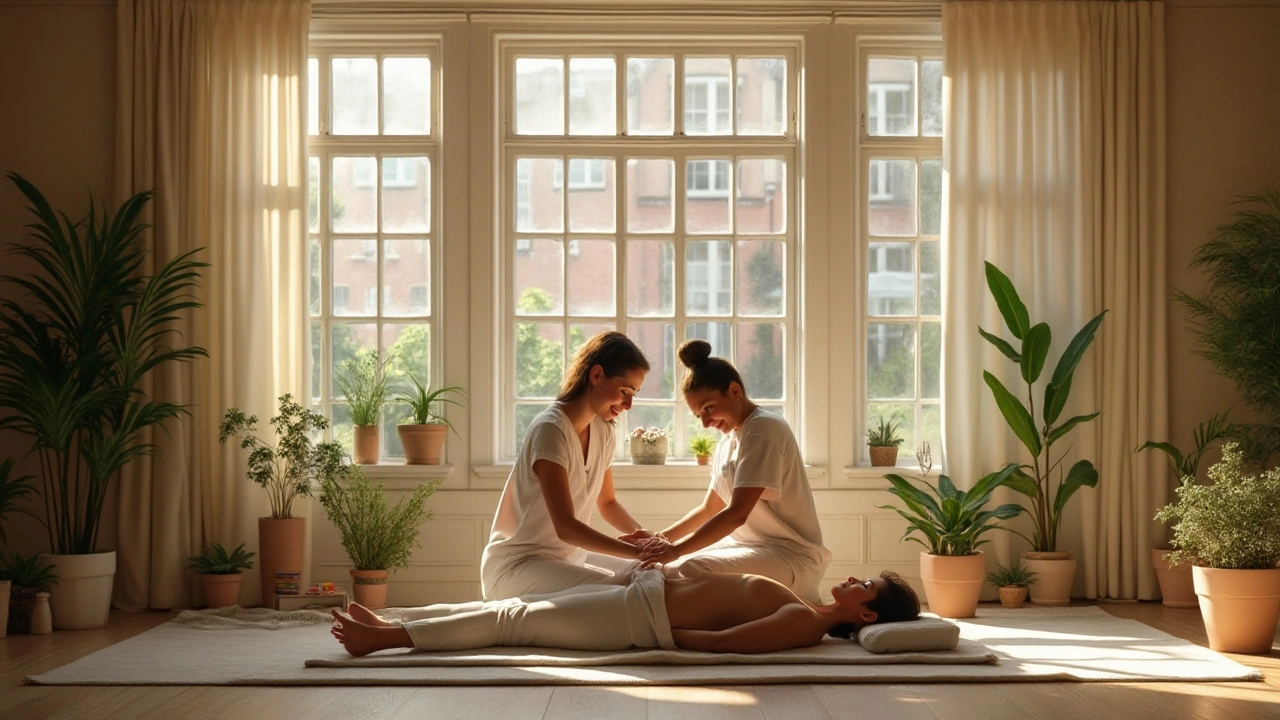Unlocking the Incredible Benefits of Breema Therapy
 Aug, 20 2024
Aug, 20 2024
In the realm of holistic health, Breema Therapy has been gaining attention for its unique approach to healing and well-being. This ancient practice combines gentle touch with guided movements to foster harmony between body and mind.
Originating from the traditions of body-mind integration, Breema is grounded in nine fundamental principles. These principles guide both the practitioner and the receiver in a session, creating a nurturing and balancing experience.
From physical benefits like improved flexibility and pain relief to emotional perks such as reduced anxiety and increased mental clarity, Breema Therapy offers a holistic path to better health. Whether you're a long-time wellness enthusiast or new to complementary therapies, incorporating Breema can bring a new level of vitality and balance to your life.
- What is Breema Therapy?
- Physical Health Benefits
- Mental and Emotional Wellness
- Principles of Breema
- Tips for Practicing Breema
What is Breema Therapy?
Breema Therapy is a unique form of bodywork techniques and movement that originated in the Middle East. Rooted deeply in the wisdom of ancient traditions, it emphasizes a holistic approach, focusing on harmonizing the mind, body, and emotions. Unlike many other therapies, Breema sessions involve a combination of practitioner-assisted movements and gentle bodywork, which both aim to nurture a deep state of presence and awareness.
This practice isn't just about relaxation or physical relief; it's a philosophy of life that encourages self-discovery and balance. One of the core tenets of Breema is the connection between the practitioner's and receiver's energy, facilitating a mutual exchange that enhances the healing process. During a session, a practitioner might use stretches, rhythmic movements, and postures, all performed with a sense of mindfulness and compassion.
Breema Therapy is based on nine guiding principles such as body comfortable, no extra, and mutual support. These principles create a framework that guides every session and helps both practitioners and recipients deepen their connection to the present moment. They serve as a reminder to listen to one's body and respond to its needs without judgment.
"Breema is a practical method for finding balance, harmony, and presence in your life," says Jon Schreiber, Director of the Breema Center in Oakland, California. "It offers a direct experience of genuine aliveness that can extend into all activities."
Practitioners often report an increased sense of vitality and clarity, describing the therapy as a way to reset the nervous system and restore balance. Its benefits are not limited to physical relaxation but also include emotional and mental well-being. The practice encourages self-acceptance and the development of a nurturing attitude towards oneself, which can be incredibly empowering.
Whether you're aiming to enhance your mind-body connection or seeking relief from stress and pain, Breema Therapy offers a comprehensive approach. It can be particularly beneficial for those who find it challenging to still their minds through traditional meditation practices. By engaging the body in mindful movement, Breema provides a more accessible pathway to achieve a tranquil state.
Physical Health Benefits
Breema Therapy stands out as a versatile method to improve physical health. This ancient art of bodywork involves rhythmic movements that create a harmony between the practitioner and the recipient. One of the most groundbreaking benefits is its ability to improve flexibility and range of motion. Regular sessions help in loosening tight muscles and joints, which is crucial for those who lead a sedentary lifestyle or suffer from conditions like arthritis.
Another notable benefit is pain relief. Whether you’re dealing with chronic pain or recovering from an injury, Breema Therapy can be an effective complementary treatment. It stimulates blood flow and reduces inflammation, making it easier for the body to heal naturally. This kind of therapy also focuses on correct body alignment. When your body is properly aligned, it prevents wear and tear on your muscles and joints.
Moreover, Breema sessions often result in better posture. Since modern life includes long hours of sitting and staring at screens, issues like back pain and neck stiffness are becoming increasingly common. Breema’s gentle movements and mindful touch work together to counteract these effects, helping you stand taller and move with ease.
Incorporating Breema into your routine can also be beneficial for your circulatory system. By promoting better blood flow, it improves oxygen delivery to your tissues. Over time, this can enhance your vitality and reduce fatigue. Improved circulation also has the added benefit of aiding in detoxification, helping your body to get rid of waste products more efficiently.
The holistic nature of Breema means it's not just about physical touch. A typical session encourages a deep state of relaxation, which in turn helps to lower blood pressure. When you’re more relaxed, your body is less likely to be in a state of ‘fight or flight,’ so you’re naturally lowering stress-related physical symptoms.
Additionally, the physical benefits aren’t limited to just the receiver. Practitioners also note improvements in their physical well-being. Since Breema involves a lot of mindful movement, it requires the practitioner to stay physically fit and aware of their body mechanics. This mutual benefit makes Breema a unique form of therapy that nurtures both parties involved.
Dr. Sandra Wilson, a leading expert in holistic health, says, 'The gentle rhythmic movements of Breema not only alleviate physical pain but also enhance the body's natural ability to heal itself.'
Finally, Breema Therapy promotes better sleep. Poor sleep is often the result of accumulated stress and tension in the body. The relaxing and harmonizing effects of Breema can help to release this built-up tension, paving the way for a restful night’s sleep. So, if you’re struggling with insomnia or poor sleep quality, this could be a natural remedy worth exploring.

Mental and Emotional Wellness
The impact of Breema Therapy on mental and emotional wellness cannot be overstated. This bodywork technique is specifically designed to foster a deep sense of presence and connection. As practitioners and receivers engage in guided movements and gentle touch, they naturally become more attuned to their inner states. This heightened awareness promotes emotional balance and mental clarity, which are essential ingredients for holistic well-being.
One of the standout benefits of Breema is its potential to reduce stress and anxiety. The practice encourages a sense of relaxation that can mitigate the effects of chronic stress, a known factor in many health issues. When the body is at ease, the mind often follows suit. This creates a positive feedback loop, making it easier to handle life's challenges with a calm and collected demeanor.
Additionally, Breema offers tools for enhancing emotional resilience. By grounding oneself in the present moment, individuals can better face emotions as they arise without becoming overwhelmed. This allows for a healthier processing of feelings and a reduced likelihood of emotional burnout. The practice of Breema can serve as a form of emotional regulation, helping people navigate day-to-day life with greater stability.
Recent studies have begun to explore the therapeutic benefits of Breema on mental health. While more research is needed, preliminary findings are promising. For instance, some practitioners report enhanced mood stability and a reduction in symptoms of depression. The integrative nature of Breema makes it a complementary addition to more traditional mental health treatments, offering a holistic approach to recovery.
"Breema’s holistic approach to bodywork promotes a deeply nourishing experience, capable of supporting mental and emotional balance in ways conventional methods often cannot," says Dr. Jane Peterson, a leading expert in holistic health.
Moreover, the communal aspect of Breema should not be overlooked. Practicing this therapy often involves a sense of shared humanity, fostering connections not only between practitioner and receiver, but also within a community of practitioners. This communal bond can be incredibly supportive, particularly for those who might feel isolated due to mental health struggles.
Incorporating Breema into daily routines can also bring lasting benefits. Practitioners often recommend simple self-Breema exercises that individuals can perform at home. These exercises are designed to maintain the relaxed and balanced state achieved during a session. This practice reinforces the principles of presence and awareness, making it easier to carry these qualities into everyday life.
As we navigate an increasingly stressful world, the need for methods that support mental and emotional wellness is more urgent than ever. Breema Therapy offers a time-tested approach that not only addresses immediate stressors but also builds long-term resilience. Its combination of gentle movements, principles of mindfulness, and community support create a robust foundation for mental and emotional health. For anyone seeking a holistic approach to wellness, Breema can be a valuable addition to their toolkit.
Principles of Breema
The principles of Breema Therapy are fundamental to understanding this unique art of touch and movement. The practice is built upon nine essential principles, each contributing to the holistic approach that promotes healing and well-being. Let's delve into these principles to grasp how they facilitate a transformative experience.
The first principle is Body Comfortable. This principle emphasizes the importance of comfort both for the practitioner and the receiver of the therapy. During a session, making sure that both parties are at ease helps in achieving a deeper connection and more effective therapy outcomes. It’s not just about physical comfort; mental and emotional ease are equally important.
Next is No Extra, a principle that encourages simplicity and the avoidance of unnecessary effort. Whether in movement or thought, doing only what's needed allows for a more efficient and harmonious experience. This principle teaches us to trim excess and focus on what truly matters.
Firmness and Gentleness work hand in hand. This principle is about balancing strength and softness in touch, creating an environment that feels secure yet tender. It’s a fine line, but when done correctly, it can yield profound therapeutic results.
The principle of Full Participation aims at engaging the whole person – body, mind, and feelings. Whether you are giving or receiving a session, being fully present enhances the depth of the experience. This full engagement is a form of mindfulness that can have cascading positive effects on mental and emotional health.
“Breema is about using the body as a tool to become present, rather than getting lost in thoughts,” says a seasoned practitioner. This perspective shifts the focus from merely receiving therapy to becoming actively involved in one's healing journey.
Single Moment/Single Activity is another core principle. It involves giving complete attention to one activity at a time, ensuring that all actions are performed with full awareness. This singular focus helps in cultivating a state of mindful presence, which is integral to the Breema experience.
Mutual Support is crucial for the bond between practitioner and receiver. This principle stresses that true support is a two-way street, enriching both parties. The act of giving and receiving support simultaneously creates a balance that uplifts both individuals.
No Judgment encourages an environment free from criticism or evaluation. This principle helps to create a safe and accepting space where healing can occur naturally. It's about being compassionate and understanding without labeling or judging.
Leaning and Support takes the idea of mutual assistance further by highlighting the importance of physical support. Using body mechanics efficiently by leaning in enhances the quality of touch and ensures sustainability for both practitioner and receiver.
| Principle | Explanation |
|---|---|
| Body Comfortable | Emphasizing the importance of physical, mental, and emotional comfort. |
| No Extra | Avoiding unnecessary effort. |
| Mutual Support | Creating a balanced exchange of support. |
| Single Moment/Single Activity | Fostering mindful presence in every action. |
Firmness and Gentleness combined emphasize the balance of strength and softness. The last principle, Description Not Instruction, enhances this by directing actions descriptively rather than prescriptively, guiding gently without forcing.
Collectively, these principles create a holistic and supportive environment where both the giver and receiver can thrive. They are the backbone of Breema Therapy, making it a unique and deeply rewarding practice. By integrating these principles, individuals can foster a profound connection between their mind and body, unlocking a path to holistic well-being.

Tips for Practicing Breema
Incorporating Breema Therapy into your wellness routine doesn't have to be complicated. Even small, mindful adjustments can bring significant benefits. Start by creating a peaceful environment. Choose a quiet, comfortable space where you won't be interrupted. This will help in centering yourself and focusing fully on the practice. Make sure you wear comfortable clothing that allows easy movement.
Before diving into the sessions, take a few moments to center yourself. This can be as simple as closing your eyes, taking deep breaths, and setting an intention for the practice. This prepares both your mind and body to receive the full benefits of the therapy. Remember, Breema encourages a connection between the mind and body, so being mentally prepared is just as crucial as the physical preparation.
Understanding the nine principles of Breema can deepen your practice. These principles include No Extra, Firmness and Gentleness, and Single Moment/Single Activity, among others. They focus on bringing full attention to the present moment, which enhances the efficacy of the bodywork. A good exercise is to choose one principle and focus on it during your session. For instance, if you pick ‘No Extra,’ try to eliminate unnecessary movements and thoughts, keeping your focus on the essence of each touch and movement.
The Breema Center states, “When body, mind, and feelings work together in harmony, our relationship to life and everything in it becomes more harmonious.”Breema sessions can be both self-practice and partner sessions. For self-practice, explore various bodywork exercises that you can perform independently. These exercises often involve stretches, gentle pressure, and mindful movements to rejuvenate oneself. Partner sessions can enhance the experience by adding the element of shared energy. If you’re practicing with a partner, ensure clear communication and mutual consent for every movement.
Consistency is key to realizing the full benefits of Breema Therapy. Even a short daily practice can yield significant results over time. Aim to incorporate Breema into your routine in a way that feels natural and sustainable. You might start with a few minutes each day and gradually increase the duration as it becomes a comfortable part of your daily life. Reflecting on each session can be beneficial as well. Keep a journal nearby to jot down any sensations, thoughts, or emotions that arise during or after the practice. This helps in tracking your progress and understanding the impact of the therapy on your well-being.
